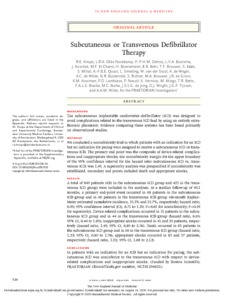Knops, RE;
Olde Nordkamp, LRA;
Delnoy, P-PHM;
Boersma, LVA;
Kuschyk, J;
El-Chami, MF;
Bonnemeier, H;
Behr, ER;
Brouwer, TF;
Kääb, S;
et al.
Knops, RE; Olde Nordkamp, LRA; Delnoy, P-PHM; Boersma, LVA; Kuschyk, J; El-Chami, MF; Bonnemeier, H; Behr, ER; Brouwer, TF; Kääb, S; Mittal, S; Quast, A-FBE; Smeding, L; van der Stuijt, W; de Weger, A; de Wilde, KC; Bijsterveld, NR; Richter, S; Brouwer, MA; de Groot, JR; Kooiman, KM; Lambiase, PD; Neuzil, P; Vernooy, K; Alings, M; Betts, TR; Bracke, FALE; Burke, MC; de Jong, JSSG; Wright, DJ; Tijssen, JGP; Wilde, AAM; PRAETORIAN Investigators
(2020)
Subcutaneous or Transvenous Defibrillator Therapy.
N Engl J Med, 383 (6).
pp. 526-536.
ISSN 1533-4406
https://doi.org/10.1056/NEJMoa1915932
SGUL Authors: Behr, Elijah Raphael
![[img]](https://openaccess.sgul.ac.uk/112274/1.hassmallThumbnailVersion/nejmoa1915932.pdf)  Preview |
|
PDF
Published Version
Available under License ["licenses_description_publisher" not defined].
Download (566kB)
| Preview
|
Abstract
BACKGROUND: The subcutaneous implantable cardioverter-defibrillator (ICD) was designed to avoid complications related to the transvenous ICD lead by using an entirely extrathoracic placement. Evidence comparing these systems has been based primarily on observational studies. METHODS: We conducted a noninferiority trial in which patients with an indication for an ICD but no indication for pacing were assigned to receive a subcutaneous ICD or transvenous ICD. The primary end point was the composite of device-related complications and inappropriate shocks; the noninferiority margin for the upper boundary of the 95% confidence interval for the hazard ratio (subcutaneous ICD vs. transvenous ICD) was 1.45. A superiority analysis was prespecified if noninferiority was established. Secondary end points included death and appropriate shocks. RESULTS: A total of 849 patients (426 in the subcutaneous ICD group and 423 in the transvenous ICD group) were included in the analyses. At a median follow-up of 49.1 months, a primary end-point event occurred in 68 patients in the subcutaneous ICD group and in 68 patients in the transvenous ICD group (48-month Kaplan-Meier estimated cumulative incidence, 15.1% and 15.7%, respectively; hazard ratio, 0.99; 95% confidence interval [CI], 0.71 to 1.39; P = 0.01 for noninferiority; P = 0.95 for superiority). Device-related complications occurred in 31 patients in the subcutaneous ICD group and in 44 in the transvenous ICD group (hazard ratio, 0.69; 95% CI, 0.44 to 1.09); inappropriate shocks occurred in 41 and 29 patients, respectively (hazard ratio, 1.43; 95% CI, 0.89 to 2.30). Death occurred in 83 patients in the subcutaneous ICD group and in 68 in the transvenous ICD group (hazard ratio, 1.23; 95% CI, 0.89 to 1.70); appropriate shocks occurred in 83 and 57 patients, respectively (hazard ratio, 1.52; 95% CI, 1.08 to 2.12). CONCLUSIONS: In patients with an indication for an ICD but no indication for pacing, the subcutaneous ICD was noninferior to the transvenous ICD with respect to device-related complications and inappropriate shocks. (Funded by Boston Scientific; PRAETORIAN ClinicalTrials.gov number, NCT01296022.).
| Item Type: |
Article
|
| Additional Information: |
From New England Journal of Medicine, Knops, RE; Olde Nordkamp, LRA; Delnoy, P-PHM; Boersma, LVA; Kuschyk, J; El-Chami, MF; Bonnemeier, H; Behr, ER; Brouwer, TF; Kääb, S; et al., Subcutaneous or Transvenous Defibrillator Therapy, 383, 526-536. Copyright © 2020 Massachusetts Medical Society. Reprinted with permission. |
| Keywords: |
PRAETORIAN Investigators, 11 Medical and Health Sciences, General & Internal Medicine |
| SGUL Research Institute / Research Centre: |
Academic Structure > Molecular and Clinical Sciences Research Institute (MCS) |
| Journal or Publication Title: |
N Engl J Med |
| ISSN: |
1533-4406 |
| Language: |
eng |
| Dates: |
| Date | Event |
|---|
| 6 August 2020 | Published | | 17 June 2020 | Accepted |
|
| Publisher License: |
Publisher's own licence |
| Projects: |
| Project ID | Funder | Funder ID |
|---|
| Investigator-sponsored research program | Boston Scientific Corporation | UNSPECIFIED |
|
| PubMed ID: |
32757521 |
 |
Go to PubMed abstract |
| URI: |
https://openaccess.sgul.ac.uk/id/eprint/112274 |
| Publisher's version: |
https://doi.org/10.1056/NEJMoa1915932 |
Statistics
Item downloaded times since 14 Aug 2020.
Actions (login required)
 |
Edit Item |



